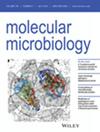Roc双组分调控系统的功能和泛基因组探索识别假单胞菌物种的新参与者
IF 2.6
2区 生物学
Q3 BIOCHEMISTRY & MOLECULAR BIOLOGY
引用次数: 0
摘要
机会致病菌铜绿假单胞菌依靠大量双组分调节系统(TCSs)来感知和适应不断变化的环境。其中,Roc (regulation of cup)系统是一个独一无二的支链TCSs网络,由两种组氨酸激酶(hk - rocs1和RocS2)与三种反应调节因子(RRs-RocA1、RocR和RocA2)相互作用,调节毒力、抗生素耐药性和生物膜形成。基于对Roc系统的广泛研究,之前的数据表明,存在其他尚未发现的关键监管机构。在这项工作中,我们确定了PA4080,重命名为RocA3,作为第四个被RocS1和RocS2激活的RR,并积极控制cupB操纵子的表达。对该位点进行比较基因组分析,在菌株亚群中发现了一个与rocA3相邻的基因- rocr3,该基因编码的蛋白质在结构和功能上与c-di-GMP磷酸二酯酶RocR相似。此外,我们确定了Roc系统的第四个分支,由PA2583 HK(更名为RocS4)和Hpt蛋白HptA组成。利用细菌双杂交系统,我们发现RocS4与HptA相互作用,而HptA又与RocA1、RocA2和RocR3相互作用。最后,我们绘制了全基因组RRs库,建立了该物种进化支系中此类调节因子可塑性的全面视图。总的来说,我们的工作提供了一个全面的物种间Roc系统的定义,几乎翻了一倍的蛋白质已知参与这个相互关联的tcs网络控制假单胞菌物种的致病性。本文章由计算机程序翻译,如有差异,请以英文原文为准。

Functional and Pangenomic Exploration of Roc Two-Component Regulatory Systems Identifies Novel Players Across Pseudomonas Species
The opportunistic pathogen Pseudomonas aeruginosa relies on a large collection of two-component regulatory systems (TCSs) to sense and adapt to changing environments. Among them, the Roc (regulation of cup) system is a one-of-a-kind network of branched TCSs, composed of two histidine kinases (HKs—RocS1 and RocS2) interacting with three response regulators (RRs—RocA1, RocR, and RocA2), which regulate virulence, antibiotic resistance, and biofilm formation. Based on extensive work on the Roc system, previous data suggested the existence of other key regulators yet to be discovered. In this work, we identified PA4080, renamed RocA3, as a fourth RR that is activated by RocS1 and RocS2 and that positively controls the expression of the cupB operon. Comparative genomic analysis of the locus identified a gene—rocR3—adjacent to rocA3 in a subpopulation of strains that encodes a protein with structural and functional similarity to the c-di-GMP phosphodiesterase RocR. Furthermore, we identified a fourth branch of the Roc system consisting of the PA2583 HK, renamed RocS4, and the Hpt protein HptA. Using a bacterial two-hybrid system, we showed that RocS4 interacts with HptA, which in turn interacts with RocA1, RocA2, and RocR3. Finally, we mapped the pangenomic RRs repertoire, establishing a comprehensive view of the plasticity of such regulators among clades of the species. Overall, our work provides a comprehensive inter-species definition of the Roc system, nearly doubling the number of proteins known to be involved in this interconnected network of TCSs controlling pathogenicity in Pseudomonas species.
求助全文
通过发布文献求助,成功后即可免费获取论文全文。
去求助
来源期刊

Molecular Microbiology
生物-生化与分子生物学
CiteScore
7.20
自引率
5.60%
发文量
132
审稿时长
1.7 months
期刊介绍:
Molecular Microbiology, the leading primary journal in the microbial sciences, publishes molecular studies of Bacteria, Archaea, eukaryotic microorganisms, and their viruses.
Research papers should lead to a deeper understanding of the molecular principles underlying basic physiological processes or mechanisms. Appropriate topics include gene expression and regulation, pathogenicity and virulence, physiology and metabolism, synthesis of macromolecules (proteins, nucleic acids, lipids, polysaccharides, etc), cell biology and subcellular organization, membrane biogenesis and function, traffic and transport, cell-cell communication and signalling pathways, evolution and gene transfer. Articles focused on host responses (cellular or immunological) to pathogens or on microbial ecology should be directed to our sister journals Cellular Microbiology and Environmental Microbiology, respectively.
 求助内容:
求助内容: 应助结果提醒方式:
应助结果提醒方式:


